Mar 16
Posted: under Activities, Plantlife, Water, Weather.
Tags: beauty, observation, photography, water resource management, Weather March 16th, 2009
Plants around here take immediate advantage of water, so the change in color after less than a week from the first drop of rain is striking. Not only does green show on the mowed maintenance path, but at the base of the taller clumps to either side. Rain started Wednesday; this was taken Sunday. Last […] [...more]
Plants around here take immediate advantage of water, so the change in color after less than a week from the first drop of rain is striking.

Near Meadow
Not only does green show on the mowed maintenance path, but at the base of the taller clumps to either side. Rain started Wednesday; this was taken Sunday. Last week, no green.
Read the rest of this entry »

Mar 09
Posted: under photography, Plantlife, Wildlife.
Tags: beauty, native plants, photography, wildlife management March 9th, 2009
We saw a Luna Moth again today. It might have been the same one or another one. This was in the mid-morning of a cloudy day, with a strong wind from the S (the other side of the fence. The white “frosting” on the forewing purple stripe is (when really enlarged) white scales mixed with […] [...more]
We saw a Luna Moth again today. It might have been the same one or another one. This was in the mid-morning of a cloudy day, with a strong wind from the S (the other side of the fence.
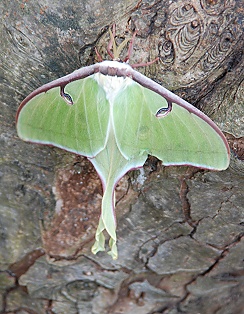
Luna Moth
The white “frosting” on the forewing purple stripe is (when really enlarged) white scales mixed with the purplish ones. You can just see the underwing eyespots showing through.
Read the rest of this entry »

Mar 07
Posted: under photography, Wildlife.
Tags: beauty, photography March 7th, 2009
Until today, I had never seen a Luna Moth. On the evening of my birthday, Richard found one clinging to a twig low under a rusty blackhaw viburnum. I rushed out with the camera. We think this moth had just emerged and begun the “stretching out” process, but we know very little about them. Richard […] [...more]
Until today, I had never seen a Luna Moth. On the evening of my birthday, Richard found one clinging to a twig low under a rusty blackhaw viburnum. I rushed out with the camera.
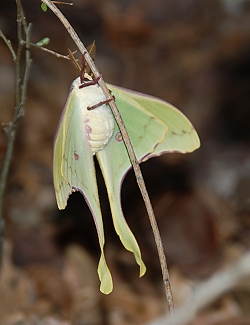
Luna Moth
We think this moth had just emerged and begun the “stretching out” process, but we know very little about them. Richard said they were fairly common in rural Alabama when he was a child, with “moth-watching parties” in the evenings.
Read the rest of this entry »

Mar 04
Posted: under Land, Plantlife, Weather, Wildlife.
Tags: beauty, native plants, photography, Weather, wildlife management March 4th, 2009
Even in a year this dry, some of the native plants (and a few non-natives) do their best to keep alive and growing. One of the natives we’ve nurtured for years in the yard is the scarlet buckeye, an understory tree that hates sun and drought–but thrives in shady canyons near permanent water. Our version […] [...more]
Even in a year this dry, some of the native plants (and a few non-natives) do their best to keep alive and growing.
One of the natives we’ve nurtured for years in the yard is the scarlet buckeye, an understory tree that hates sun and drought–but thrives in shady canyons near permanent water. Our version of that is the shade of a big old ash and regular watering. I’d like to move its progeny into the creek woods, but right now they’re far too dry (and too far away to water.) It’s just showing its flower buds now; they’ll be open in a few days.
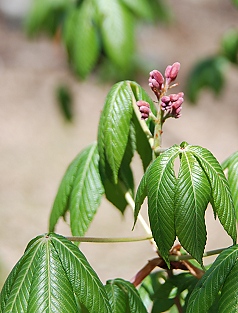
Read the rest of this entry »

Feb 26
Posted: under photography, Plantlife, Wildlife.
Tags: Animal behavior, beauty, native plants, photography February 26th, 2009
Mexican plum, the tree-sized wild plum around here, blooms even in drought years. Not only is it snowy white and beautiful, it has that amazing wild-plum fragrance…and as it’s an early bloomer, it attracts everything that’s hungry for nectar. It doesn’t look like this long–especially in a drought year–and the tiny white petals are already […] [...more]
Mexican plum, the tree-sized wild plum around here, blooms even in drought years. Not only is it snowy white and beautiful, it has that amazing wild-plum fragrance…and as it’s an early bloomer, it attracts everything that’s hungry for nectar.
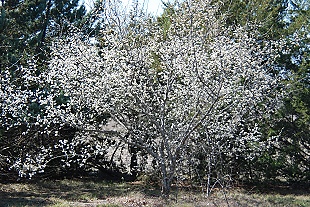
Mexican Plum in full bloom
It doesn’t look like this long–especially in a drought year–and the tiny white petals are already blowing off it in today’s stiff warm breeze.
Read the rest of this entry »

Jan 13
Posted: under Wildlife.
Tags: beauty, bird behavior, observation, photography January 13th, 2009
I have only four records in eight years for the Hermit Thrush on our place, including today, all in the creek woods. In 2003, I saw one briefly near Main Ford, right in the middle of the woods, on January 27 and again on February 2…almost certainly the same individual. In late October 2007, I […] [...more]
I have only four records in eight years for the Hermit Thrush on our place, including today, all in the creek woods. In 2003, I saw one briefly near Main Ford, right in the middle of the woods, on January 27 and again on February 2…almost certainly the same individual. In late October 2007, I saw one in the south part of the creek woods, and got a (not very good) picture. We’re “supposed” to have them–we’re in their winter range–but these birds are small, shy, and easily missed among the winter sparrows. They’re quiet and secretive. I had read descriptions of the Hermit Thrush’s song but never heard it.
Until today.
Read the rest of this entry »

Jan 12
Posted: under Activities, Plantlife, Wildlife.
Tags: Activities, Animal behavior, beauty, observation, photography, supplemental feeding, wildlife management January 12th, 2009
Today’s wildlife experience was an armadillo, drinking noisily (they slurp, sounding rather like dogs) from the overflow guzzler at Fox Pavilion when we came back around that way after a long, two-hour stroll around the place. I thought I’d turned the water off completely, but some grit must’ve been in the faucet, because the water […] [...more]
Today’s wildlife experience was an armadillo, drinking noisily (they slurp, sounding rather like dogs) from the overflow guzzler at Fox Pavilion when we came back around that way after a long, two-hour stroll around the place. I thought I’d turned the water off completely, but some grit must’ve been in the faucet, because the water had overflowed.
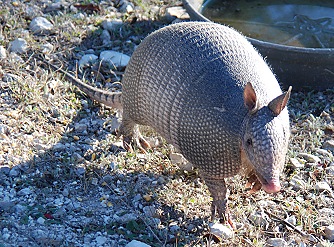
Read the rest of this entry »

Dec 24
Posted: under Wildlife.
Tags: beauty, bird behavior, observation December 24th, 2008
We have white-winged doves on our place…with the change in climate over the past 20 years, they’ve started wintering here as well (they used to migrate south in winter.) White-wings are large “dove-colored” doves–the largest native dove in the area–and except for the white flash in the wing (showing as a white stripe even on […] [...more]
We have white-winged doves on our place…with the change in climate over the past 20 years, they’ve started wintering here as well (they used to migrate south in winter.) White-wings are large “dove-colored” doves–the largest native dove in the area–and except for the white flash in the wing (showing as a white stripe even on the folded wing) they’ve always struck me as being rather plain, dull birds. They come in flocks; they’re bullies at a feeding station; they all look alike (no gender difference) and they don’t have particularly interesting songs or anything.
Silly me. Nothing in nature is really dull and plain, once we really look at it. This year the observation of white-wings has shown me something both new and colorful.
Read the rest of this entry »

Dec 12
Posted: under Sky, Weather.
Tags: beauty, Weather December 12th, 2008
In winter, the full moon (or nearly full–let’s not quibble) on a clear cold night makes the whole world silver. And when it sets–that gold coin slipping down into a blue almost the same as the shadowed bottom of a thundercloud, with a band of softest rose above it–it’s worth staring at for the entire […] [...more]
In winter, the full moon (or nearly full–let’s not quibble) on a clear cold night makes the whole world silver. And when it sets–that gold coin slipping down into a blue almost the same as the shadowed bottom of a thundercloud, with a band of softest rose above it–it’s worth staring at for the entire display. Right now it’s visible out my window–half down into the trees across the field–and I’ve been watching for almost an hour as it went from silver to the palest gold, the color deepening moment by moent to the warm golden yellow it is now, the shadow-blue slowly thinning–now with a lavender band that a moment ago was still blue, and the rose above shading to paler and paler rose until it shifts into the pale blue of the dawn sky.
A last sliver of gold now…watching and trying to type as it vanishes, the planet whirling towards dawn…and there…it’s gone.
The horses are munching morning hay. The first birds haven’t shown up yet. Now the blue band is lavender all the way to the horizon, and rapidly turning pinkish. Soon the sun will fire the tops of the red oaks.
Reasons to get up early.

Dec 09
Posted: under Land, Plantlife.
Tags: beauty, trees December 9th, 2008
A norther blew in this afternoon, so we have blue sky and sunshine–and the red oaks near the house are the reddest they’ve ever been, brilliant in the slanting light. Most of these started as acorns collected from other oaks whose color we’d noted while driving around the countryside. Then we’d watch until “red oak […] [...more]
A norther blew in this afternoon, so we have blue sky and sunshine–and the red oaks near the house are the reddest they’ve ever been, brilliant in the slanting light.
Most of these started as acorns collected from other oaks whose color we’d noted while driving around the countryside. Then we’d watch until “red oak acorn season” and see if any had fallen on a roadside verge where it would be legal to collect them. They’re not all the same–some a deep, deep red and others more scarlet or even orange-red.
The ones nearest the house have had some supplemental water (when the town’s not on water restriction, which it is right now) and are larger and more colorful than the ones we’ve put out on the land here and there. Red oaks are more subject to the local oak diseases than bur oaks, but it’s worth the risk of losing them to have this glorious late fall/early winter color.
Of course, they’re also a great wildlife resource–acorns for deer and wild turkey, nest sites for some songbirds, and plenty of insects for the little insect-eaters to go after. Thirty years ago, late November into December showed the hillsides in dark green (live oak and juniper) and varied shades of red from red oaks, but about ten years ago one of the diseases killed many of them. Oldtimers say it happened before and new oaks grew up. Maybe by planting acorns every year (even if replanted by squirrels) we’ll eventually get more out on the land.







